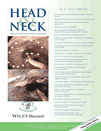Angiogenesis and lymphangiogenesis in early-stage laryngeal carcinoma: Prognostic implications
Abstract
Background
Many studies have recently emphasized the role of tumor angiogenesis and lymphangiogenesis in regional and distant spread of disease. Although early laryngeal cancer has a favorable oncologic outcome after conservative surgery or radiation therapy, we observed few cases with poor prognosis in terms of locoregional relapse, organ preservation, and survival. The aim of our study was to evaluate the immunohistochemical expression of CD31 and podoplanin to define angiogenic and lymphangiogenic patterns and their possible prognostic implications in previously untreated T1–T2 glottic squamous cell carcinoma.
Methods
Four hundred twenty-eight patients with previously untreated early-stage laryngeal cancer underwent a laser surgical resection in the period between January 1994 and December 2007. Twenty-seven cases with poor outcome were identified and compared with a selected sample of 28 patients. All specimens were negative for the presence of high-risk human papillomavirus genotypes. Patients were followed up until death or for at least 24 months after treatment. Three-micrometer sections were obtained from formalin-fixed and paraffin-embedded tumoral tissues, and an immunohistochemical evaluation was performed. Monoclonal antibodies against CD31 and podoplanin were used for the detection of blood and lymphatic vessels, respectively. A morphometric measurement was used for the analysis of angiogenesis whereas lymphangiogenesis was studied with a semiquantitative technique. The data were analyzed by use of chi-square and Mann-Whitney tests as appropriate.
Results
An increased tumor angiogenesis correlated with local relapse (p = .01), locoregional relapse (p = .01), and death of disease (p = .03). The presence of lymphatic vessels in peritumoral fields had an impact on local (p = .004) and locoregional recurrence (p = .01).
Conclusions
Evaluation of angiogenesis and lymphangiogenesis in early-stage laryngeal cancer could be useful to identify patients at higher risk of recurrence and consequently to modulate treatment planning and follow-up strategy. © 2012 Wiley Periodicals, Inc. Head Neck, 2013




